英语介词知识点用法总结
初一英语介词的知识点归纳
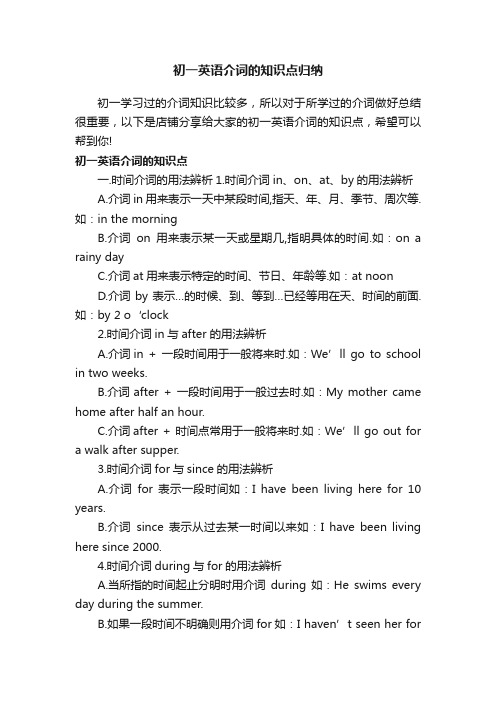
初一英语介词的知识点归纳初一学习过的介词知识比较多,所以对于所学过的介词做好总结很重要,以下是店铺分享给大家的初一英语介词的知识点,希望可以帮到你!初一英语介词的知识点一.时间介词的用法辨析1.时间介词in、on、at、by的用法辨析A.介词in用来表示一天中某段时间,指天、年、月、季节、周次等.如:in the morningB.介词on用来表示某一天或星期几,指明具体的时间.如:on a rainy dayC.介词at用来表示特定的时间、节日、年龄等.如:at noonD.介词by表示…的时候、到、等到…已经等用在天、时间的前面.如:by 2 o‘clock2.时间介词in与after 的用法辨析A.介词in + 一段时间用于一般将来时.如:We’ll go to school in two weeks.B.介词after + 一段时间用于一般过去时.如:My mother came home after half an hour.C.介词after + 时间点常用于一般将来时.如:We’ll go out fora walk after supper.3.时间介词for与since的用法辨析A.介词for 表示一段时间如:I have been living here for 10 years.B.介词since 表示从过去某一时间以来如:I have been living here since 2000.4.时间介词during与for的用法辨析A.当所指的时间起止分明时用介词during如:He swims every day during the summer.B.如果一段时间不明确则用介词for如:I haven’t seen her foryears.5.时间介词before与by的用法辨析A.介词before表示“在…之前”如:He won’t come back before five .B.介词by表示“到…时为止,不迟于…”如:The work must be finished by Friday.6.时间介词till与until用法的异同A.till和until用在肯定句中,均可表示“直到…为止”,如:I will wait till(until)seven o'clock.B.till和until用在否定句中,均可表示“在…以前”或“直到…才”.如:Tom didn't come back till(until)midnight.C.till多用于普通文体,而 until则用于多种文体,并且在句子开头时,用until而不用till.如:Until he comes back,nothing can be done.7.不用介词表达时间的几种情况A.当表示时间的词前有this, that时,其前面不用介词,如:this morningB.当表示时间的词前有next时,其前面不用介词,如:next SundayC.当表示时间的词前有last时,其前面不用介词,如:last SundayD.当表示时间的词前有one, any, each, every, some或all时,其前面不用介词,如:You can come any day.二.方位介词与地点介词的用法辨析1.方位介词on, over, above的用法辨析A.介词on表示一物放在另一物上面,两者紧贴在一起,如:The book is on the table.B.介词over表示一种垂直悬空的上下关系,即“在…上方”,如:Is there any bridge over the river?C.介词above表示一般的“高于…”,“在…之上”,如:There was an electric clock above his bed.2.方位介词under与below的用法辨析A.介词under是over的反义词即“在…下方”,如:They were seen under the tree.B.介词below是above的反义词即“低于…”,“在…之下”,如:They live below us.3.方位介词across,、through、over,、past的用法辨析A.介词across着重于“从一头或一边到另一头或另一边”,强调从表面穿过.如:She went across the street to make some purchases.B.介词through着重于“穿越”,强调从一定的空间内穿过.如:The sunlight was coming in through the window.C.介词over多表示从“上方越过”,如:He failed to go over the mountain; he had to go round it.D.介词past表示从“面前经过”,如:Someone has just gone past the window.4.方位介词in、on、at的用法辨析A.介词in表示“排、行、组”,如:We are in Team One.B.介词on表示“左、右”,如:Li Ping is on my left.C.介词at表示“前、后”,如:I sit at the front of the classroom.5.方位介词to、for的用法辨析A.介词to表示目的地或去的目的,如:Wil you take a train to Tianjian.B.介词for表示动身去某地,如:He got on a train for Shanghai.6.地点介词at与in的用法辨析A.介词at表示较小的地方,如家、村、乡村等,如:He lives at a small village.B.介词in表示较大的地方,如大城市、国家、洲等,如:He lives in Beijing.7.地点介词at与on的用法辨析A.介词at用于门牌号,如:He lives at No.200, Nanjing Road.B.介词on用于路名,如:He lives on Nanjing Road.8.地点介词in、on、to的用法辨析A.介词in表示“包含”如:Beijing is in the north of China.B.介词on表示“紧邻”如:Canada lies on the north of the U.S.C.介词to表示“没接触”如:France lies to the south of England.初一学好英语的建议一、培育学习英语的兴致爱因斯坦以前说过:“兴致和喜好是最好的老师。
介词使用方法归纳

介词使用方法归纳介词是连接名词、代词、动词或其他词语与其后常跟的名词短语、动词短语或从句的一种词类。
以下是介词的一些使用方法归纳:1. 表示时间:at, in, on, during, before, after, until等。
例如:at 9 o'clock, in the morning, on Monday, during the summer, before dinner, after school, until tomorrow等。
2. 表示地点:in, on, at, by等。
例如:in the room, on the table, at the park, by the river等。
3. 表示方式:by, with等。
例如:by car, with a smile等。
4. 表示原因:because of, due to等。
例如:because of the rain, due to the traffic等。
5. 表示目的:for, to等。
例如:for fun, to learn等。
6. 表示比较:than等。
例如:bigger than, taller than等。
7. 表示关系:of, to等。
例如:a book of poetry, a friend to me等。
8. 表示顺序:at, above, below, beside等。
例如:at the top, above the line, below the surface, beside the lake等。
9. 表示方式:with, by等。
例如:with a pen, by train等。
10. 表示动作发生的对象:to, for等。
例如:give the book to me, buy a gift for him等。
需要注意的是,介词的使用往往需要根据具体的语境而定,所以在学习和使用中需要不断积累和理解具体的用法。
高中英语介词知识点
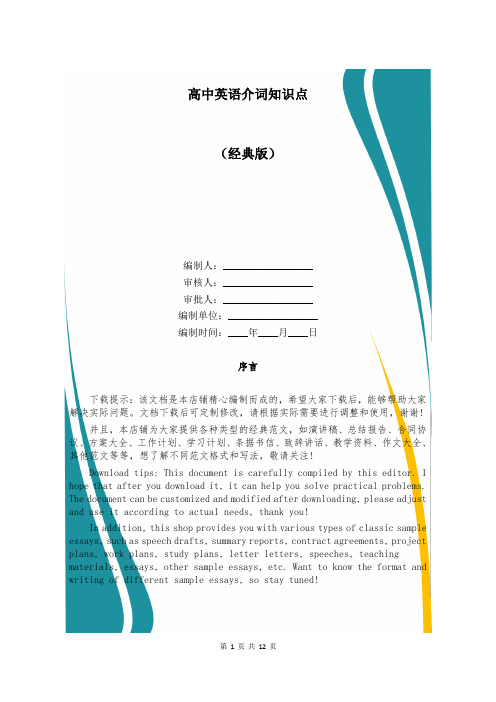
高中英语介词知识点(经典版)编制人:__________________审核人:__________________审批人:__________________编制单位:__________________编制时间:____年____月____日序言下载提示:该文档是本店铺精心编制而成的,希望大家下载后,能够帮助大家解决实际问题。
文档下载后可定制修改,请根据实际需要进行调整和使用,谢谢!并且,本店铺为大家提供各种类型的经典范文,如演讲稿、总结报告、合同协议、方案大全、工作计划、学习计划、条据书信、致辞讲话、教学资料、作文大全、其他范文等等,想了解不同范文格式和写法,敬请关注!Download tips: This document is carefully compiled by this editor. I hope that after you download it, it can help you solve practical problems. The document can be customized and modified after downloading, please adjust and use it according to actual needs, thank you!In addition, this shop provides you with various types of classic sample essays, such as speech drafts, summary reports, contract agreements, project plans, work plans, study plans, letter letters, speeches, teaching materials, essays, other sample essays, etc. Want to know the format and writing of different sample essays, so stay tuned!高中英语介词知识点介词的英语全称为“preposition”是由“前缀pre-(在……前部)+position(位置)”构成的,所以又叫前置词。
英语介词知识点归纳
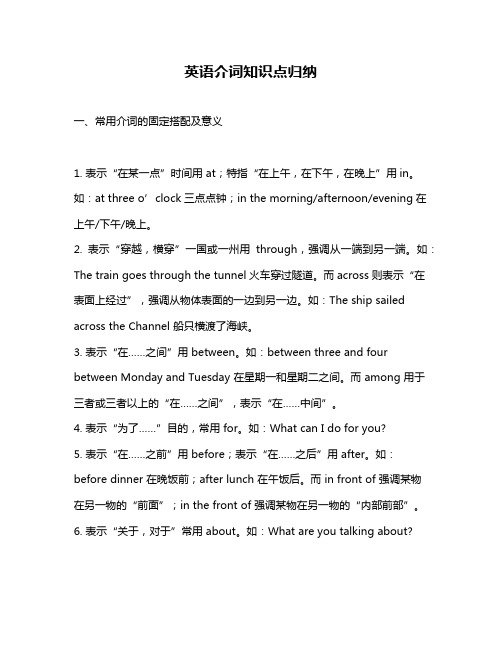
英语介词知识点归纳一、常用介词的固定搭配及意义1. 表示“在某一点”时间用 at;特指“在上午,在下午,在晚上”用in。
如:at three o’clock三点点钟;in the morning/afternoon/evening在上午/下午/晚上。
2. 表示“穿越,横穿”一国或一州用through,强调从一端到另一端。
如:The train goes through the tunnel火车穿过隧道。
而across则表示“在表面上经过”,强调从物体表面的一边到另一边。
如:The ship sailed across the Channel 船只横渡了海峡。
3. 表示“在……之间”用 between。
如:between three and four between Monday and Tuesday 在星期一和星期二之间。
而 among 用于三者或三者以上的“在……之间”,表示“在……中间”。
4. 表示“为了……”目的,常用 for。
如:What can I do for you?5. 表示“在……之前”用 before;表示“在……之后”用 after。
如:before dinner 在晚饭前;after lunch 在午饭后。
而 in front of 强调某物在另一物的“前面”;in the front of 强调某物在另一物的“内部前部”。
6. 表示“关于,对于”常用 about。
如:What are you talking about?7. 表示“除了……之外”用 except 或 besides。
如:All are here except Tom./ Besides you, I also know the answer.8. 表示“一个接一个,连续地”用 in turn。
如:They took the presents in turn.9. 表示“自……至……用from…to…” 如:from Monday to Friday 从星期一到星期五10. 表示“一方面的……另一方面……”常用 on one hand, on the other hand”。
介词用法总结-高考英语知识点

介词用法总结-高考英语知识点
in表示在区域的里面;on表示在区域的边界附近,可以是属于这个区域的一部分或相互接壤;off也表示在区域的边界附近,但一般不是属于这个区域的一部分;to表示在区域的边界更远些的附近,所以不是属于这个区域的一部分或不互相接壤。
③表示原因的介词for常常表示褒贬、奖惩的原因或心理原因。
From 和out of常常表示动机或原因;through表示消极或间接的原因。
Due to常常用来引导形容词性的短语,作定语或表语。
四、介词短语的作用
介词和它的宾语构成介词词组,其用法如下:(1)作定语:The girl in red is my sister.穿红衣的那个女孩是我妹妹。
注:介词短语作定语总是放在它所修饰的名词后面。
(2)作状语:Can you say it in English?这个你会用英语说吗?(3)作表语:He’s in the office.他在办公室。
(4)作补语:I always find her at her studies.我经常发现她在学习。
(5)作介词宾语:I saw her from across the street.我从街对面望见了她。
英语介词知识点归纳
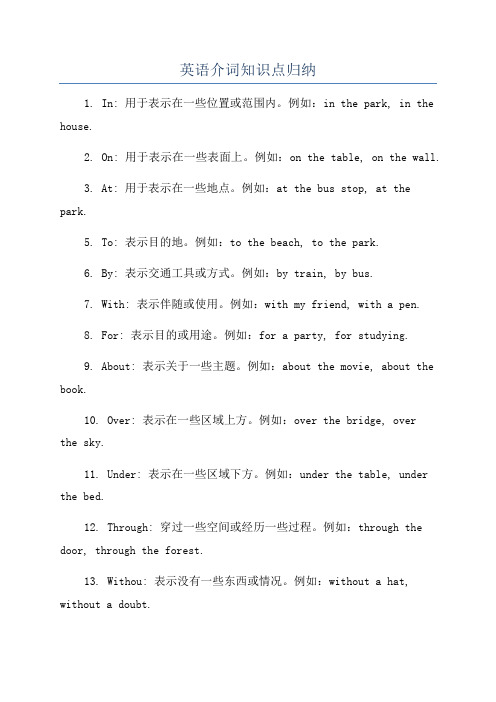
英语介词知识点归纳1. In: 用于表示在一些位置或范围内。
例如:in the park, in the house.2. On: 用于表示在一些表面上。
例如:on the table, on the wall.3. At: 用于表示在一些地点。
例如:at the bus stop, at the park.5. To: 表示目的地。
例如:to the beach, to the park.6. By: 表示交通工具或方式。
例如:by train, by bus.7. With: 表示伴随或使用。
例如:with my friend, with a pen.8. For: 表示目的或用途。
例如:for a party, for studying.9. About: 表示关于一些主题。
例如:about the movie, about the book.10. Over: 表示在一些区域上方。
例如:over the bridge, overthe sky.11. Under: 表示在一些区域下方。
例如:under the table, under the bed.12. Through: 穿过一些空间或经历一些过程。
例如:through the door, through the forest.13. Withou: 表示没有一些东西或情况。
例如:without a hat, without a doubt.14. Above: 表示在物之上。
例如:above the clouds, above the sign.15. Below: 表示在物之下。
例如:below the surface, below the line.。
介词以及介词的用法

介词以及介词的用法一、介词的定义和作用介词是一种独立成分,一般以一个或多个音节构成,并放在名词、代词等前面,表示名词与其他成分之间的关系。
它在句子中主要起到连接作用,使得句子结构更加完整。
二、常见的介词1. 在空间位置上表示方位:在、里、上、下、近等。
2. 表示时间关系:在、于、自从等。
3. 表示方式及手段:以(为),用,靠等。
4. 表示目的:为了、向等。
5. 表示原因和结果:因为、由于、所以等。
6. 表示比较对象:比,像等。
7. 其他常见介词:除了,关于,对于等。
三、固定搭配和常见用法1. 在+地点/具体场所:在家,在学校,在办公室,在餐厅等。
例如:“我在家里学习。
”2. 在+时间:在早上,在周末,在过去,现在,在将来等。
例如:“我们将在周末去旅行。
”3. 对+人/事物:对妈妈说谢谢,对这个问题持有不同意见。
例如:“他对我很友好。
”4. 通过/凭借+手段:通过努力,凭借智慧等。
例如:“他通过勤奋学习取得了好成绩。
”5. 为了+目的:为了保护环境,为了实现梦想等。
例如:“我每天早起为了健康。
”6. 因为/由于+原因:因为下雨,由于生病等。
例如:“他迟到因为交通堵塞。
”7. 比+比较对象:比爸爸高,比你小等。
例如:“这本书比那本书有趣。
”8. 除了+例外:除了他,我们都同意这个计划。
例如:“他除了唱歌还会跳舞。
”四、注意事项和常见误区1. 定冠词与介词的区别:定冠词“the”用来限定名词,而介词则是连接名词与其他成分的关系。
2. 正确搭配:不同介词在不同句型中的搭配是固定的,请务必正确使用。
例如:“坐在桌子前面”(错误)应该改为“坐在桌子后面”(正确)。
3. 熟记惯用表达:一些习语和固定表达中使用的介词并不是按照字面意思使用的,需要进行记忆。
例如:“在…方面”表示“在某一方面上”、“对于…来说”表示“就某人来说”。
总结:介词在语言中扮演着重要的角色,它能够帮助我们表达出更准确、更清晰的句子。
通过熟练掌握常见的介词及其用法,我们可以更加流利地表达自己的意思。
中考英语常用介词知识点总结

中考英语常用介词知识点总结一.表示时间的介词1. in, on, at在……(之时)①in与年、季节、月、年代、世纪及一般(泛指)的早、中、晚等较长时间的词连用eg:in summer在夏天;in January在1月;in 2012 在2012年;in the morning在早上in the 21st century②on用于具体的某日或某特定日期的早、中、晚。
如:on August 8th在8月8日;on Monday在星期一;on New Year’s Day;on a cold morning在一个寒冷的早晨;on Sunday afternoon在星期天下午。
③at表示某一时刻。
如:at 5∶10pm 在下午5∶10;at the beginning of在开始时;at the end of...在……的末尾;at the age of...在……岁时;at noon在中午;at the same time在同时。
at night在晚上;2. in, after 在……之后“in +时间段”用于将来时之中;“after+时间段”用于过去时态之中;“after+时间点”既可用于将来时也可用于过去时。
如:Jim will go to Beijing in five days.吉姆五天后会去北京。
Jim went to Beijing after five days.五天后,吉姆去了北京。
Jim will go to Beijing after five o’clock.吉姆会在五点钟后去北京。
3. for, sincefor可以指过去、现在或将来,着重说明“多久”,后面接时间段。
since意为“自从……起”,多与完成时连用,后面接时间点或从句。
since引导的从句通常为一般过去时。
如:He has lived here for 2 weeks./ He has lived here since 2 weeks ago.It’s five years since he left school.4. after, behind 在……之后after主要用于表示时间;behind主要用于表示位置。
英语介词知识点的归纳

英语介词知识点的归纳(经典版)编制人:__________________审核人:__________________审批人:__________________编制单位:__________________编制时间:____年____月____日序言下载提示:该文档是本店铺精心编制而成的,希望大家下载后,能够帮助大家解决实际问题。
文档下载后可定制修改,请根据实际需要进行调整和使用,谢谢!并且,本店铺为大家提供各种类型的经典范文,如演讲稿、总结报告、合同协议、方案大全、工作计划、学习计划、条据书信、致辞讲话、教学资料、作文大全、其他范文等等,想了解不同范文格式和写法,敬请关注!Download tips: This document is carefully compiled by this editor. I hope that after you download it, it can help you solve practical problems. The document can be customized and modified after downloading, please adjust and use it according to actual needs, thank you!In addition, this shop provides you with various types of classic sample essays, such as speech drafts, summary reports, contract agreements, project plans, work plans, study plans, letter letters, speeches, teaching materials, essays, other sample essays, etc. Want to know the format and writing of different sample essays, so stay tuned!英语介词知识点的归纳介词又叫前置词,一般放在名词的前面。
语法|英语介词知识点用法总结!

语法|英语介词知识点用法总结!1.In(在,表示时间、地点、状态):- 表示具体的时间点或时间段:in the morning(早晨)、in May(五月)、in 2024(2024年)- 表示地点:in the park(在公园里)、in London(在伦敦)- 表示状态:in trouble(陷入困境)、in love(恋爱中)2.On(在,表示时间、地点、表面):- 表示具体的日期或星期几:on Monday(星期一)、on December25th(12月25日)- 表示地点:on the bus(在公交车上)、on Main Street(在主街上)- 表示表面:on the table(在桌子上)3.At(在,表示时间、地点):- 表示具体的时间:at 8 o'clock(在8点钟)、at noon(在中午)- 表示地点:at the cinema(在电影院)、at home(在家)4.To(到,表示方向或目的地):- 表示目的地:a trip to Paris(巴黎之行)、a letter to John (写给约翰的信)- 表示出发地:a flight from New York(从纽约起飞的航班)、a train from London(从伦敦开出的火车)- 表示原因:suffer from a cold(患感冒)6. For(为了,表示目的、受益人):- 表示目的:study for the exam(为考试而学习)、buy flowers for my mother(给母亲买花)- 表示受益人:a gift for you(给你的礼物)7. With(和,表示伴随、使用、具备):- 表示伴随:go shopping with friends(和朋友一起购物)、have dinner with family(和家人一起吃晚饭)- 表示使用:write with a pen(用钢笔写)- 表示具备:a girl with long hair(一位长发的女孩)以上是一些常见的英语介词及其用法总结,介词在句子中使用灵活多样,需要根据具体语境来选择适当的介词。
中考英语介词的用法讲解

中考英语介词的用法讲解一、知识框架二、知识点梳理一、定义:介词:是一种用来表示词与词、词与句之间的关系的词,在句中不能单独作句子成分。
二、介词短语的句法作用1、介词短语相当于一个形容词或副词,可用作状语、定语和表语。
如:The man came <down the stairs>.(状)The woman <with a flower on her head> is from the countryside.(定)The teacher is now with the pupils.(表)(老师现在和学生在一起)2、介词短语在句子中的位置:介词短语做状语时,如果表示时间/地点,可以放在句首或句尾。
如果表示方向/方式/伴随/涉及/原因/目的/比较,一般放在句尾;介词短语作表语时放在连系动词之后;介词短语作定语时,只能放在被修饰的名词之后。
如:He wanted to find a good job in Shanghai the next year.(状语)They searched the room for the thief.The letters are for you.(表语)Have you seen a cat with a black head and four white legs?(定语)三、介词用法(一)表时间的介词:1.at通常用于:(表示在某个时刻或者瞬间)at+时间点,节日(泛指圣诞节、新年等整个假期时,要用at)如:at 7:30; at lunch time; at Christmas 在圣诞节期间固定词组搭配:at dawn, at night, at midnight, at noon, at that time, at the moment2. on通常用于:(表示在具体的某一天或者某天的上下午等)on+具体时间(日期,星期几)on October 1st ; on Monday; on a rainy morning; on Teachers’ Dayon Christmas Day 在圣诞节这一天3. in通常用于:(表示在一段时间里)①in+世纪/年/月/季节/早/中/晚in the 20th century, in the late 18th century②特定的年龄段,in his thirties (在他30多岁时)补充1:表示“在一段时间之后”,句子常用一般将来时。
初中英语介词知识点归纳

初中英语介词知识点归纳介词是英语中非常重要的一部分,它用来建立词与词、句与句之间的关系,能够使句子结构更加完整且信息更加准确。
在初中英语学习中,了解和掌握介词的用法和常见的搭配是非常重要的。
下面就来归纳一些初中英语中常见的介词知识点。
1. 表示地点的介词常见的表示地点的介词有:at, in, on, under, above, below, near, beside等。
例如:- I live in a big city.- The book is on the table.- The cat is under the chair.- The bird is flying above the tree.- She is standing beside her friend.2. 表示时间的介词常见的表示时间的介词有:at, in, on, before, after, during, for等。
例如:- I go to school at 7 o'clock.- We have a holiday in summer.- She always listens to music before going to bed.- They play soccer after school.- We studied for two hours.3. 表示原因的介词常见的表示原因的介词有:because of, due to, thanks to等。
例如:- He couldn't come because of the bad weather.- The match was canceled due to the heavy rain.- Thanks to your help, I finished my homework.4. 表示目的的介词常见的表示目的的介词有:for, to等。
例如:- He bought a gift for his mother.- She went to the supermarket to buy some food.5. 表示方式的介词常见的表示方式的介词有:by, with等。
介词与介词短语英语知识点总结

介词与介词短语英语知识点总结介词是一种用来表示名词与其他词或短语之间关系的词类。
常见的介词有in, on, at, for, with等。
1. 位置关系:- 在某位置:in, on, atin表示在物体或空间内部,on表示在物体表面,at表示在具体位置或某地。
例句:He is in the room. She is sitting on the chair. They are waiting at the bus stop.- 离开某位置:from, off, out offrom表示离开某一具体位置,off表示从某一表面离开,out of表示从某一空间或物体内部离开。
例句:He is coming from the airport. The cat jumped off the table. She took her phone out of her bag.2. 时间关系:- 表示具体时间:in, on, atin表示在某一段时间内,on表示在某一具体日期或星期,at 表示在某一具体时间。
例句:We will have a meeting in the afternoon. I will see him on Monday. The movie starts at 7 o'clock.- 表示时间段:during, forduring表示在某一整个时间段内,for表示在某一时间段的持续时间。
例句:He slept during the night. I will stay here for a week.3. 关系连接:- 表示原因:because of, due tobecause of表示由于,due to表示由于(正式用语)。
例句:He couldn't come because of the rain. The event was canceled due to bad weather.- 表示目的:for, tofor表示为了某一目的,to表示向某一目的地或对象。
介词的知识点总结
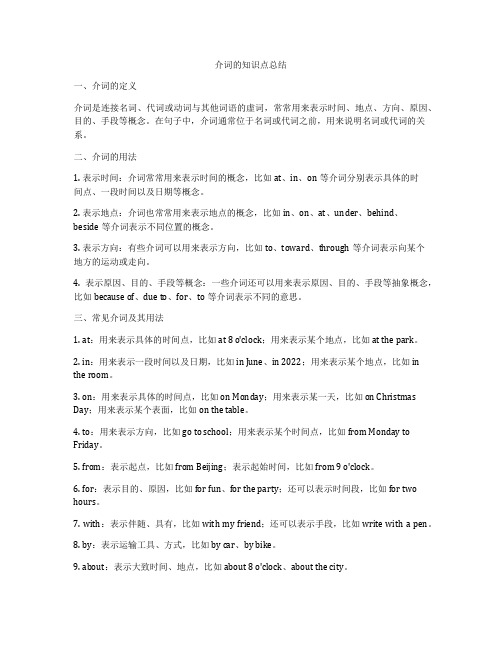
介词的知识点总结一、介词的定义介词是连接名词、代词或动词与其他词语的虚词,常常用来表示时间、地点、方向、原因、目的、手段等概念。
在句子中,介词通常位于名词或代词之前,用来说明名词或代词的关系。
二、介词的用法1. 表示时间:介词常常用来表示时间的概念,比如at、in、on等介词分别表示具体的时间点、一段时间以及日期等概念。
2. 表示地点:介词也常常用来表示地点的概念,比如in、on、at、under、behind、beside等介词表示不同位置的概念。
3. 表示方向:有些介词可以用来表示方向,比如to、toward、through等介词表示向某个地方的运动或走向。
4. 表示原因、目的、手段等概念:一些介词还可以用来表示原因、目的、手段等抽象概念,比如because of、due to、for、to等介词表示不同的意思。
三、常见介词及其用法1. at:用来表示具体的时间点,比如at 8 o'clock;用来表示某个地点,比如at the park。
2. in:用来表示一段时间以及日期,比如in June、in 2022;用来表示某个地点,比如in the room。
3. on:用来表示具体的时间点,比如on Monday;用来表示某一天,比如on Christmas Day;用来表示某个表面,比如on the table。
4. to:用来表示方向,比如go to school;用来表示某个时间点,比如from Monday to Friday。
5. from:表示起点,比如from Beijing;表示起始时间,比如from 9 o'clock。
6. for:表示目的、原因,比如for fun、for the party;还可以表示时间段,比如for two hours。
7. with:表示伴随、具有,比如with my friend;还可以表示手段,比如write with a pen。
介词知识点笔记总结

介词知识点笔记总结一、介词的定义介词是一种用来连接名词、代词或动名词等与其他词语之间关系的词类。
介词通常用来表示时间、地点、方向、原因等。
常见的介词有:in, on, at, under, above, with, of, for, to, from等。
例如:- He is in the room.(他在房间里。
)- The book is on the table.(书在桌子上。
)- She goes to school by bus.(她坐公交车去学校。
)二、介词的分类1. 时间介词时间介词用来表示时间的概念,常见的时间介词有:at, in, on等。
例如:- We have a meeting at 3 o’clock.(我们三点钟开会。
)- My birthday is in April.(我的生日在四月。
)- She will come on Monday.(她星期一来。
)2. 地点介词地点介词用来表示地点或位置的概念,常见的地点介词有:in, on, at, under, above, below, between, among等。
例如:- The cat is under the table.(猫在桌子下面。
)- The school is between the bank and the park.(学校在银行和公园之间。
)- She is among her friends.(她在她的朋友中间。
)3. 方向介词方向介词用来表示方向的概念,常见的方向介词有:to, from, into, out of等。
例如:- She goes to school by bike.(她骑自行车去学校。
)- He comes from China.(他来自中国。
)- The cat jumps into the box.(猫跳进箱子里。
)4. 原因介词原因介词用来表示原因或目的的概念,常见的原因介词有:for, because of, due to等。
高中英语知识点归纳介词的常见搭配和固定用法
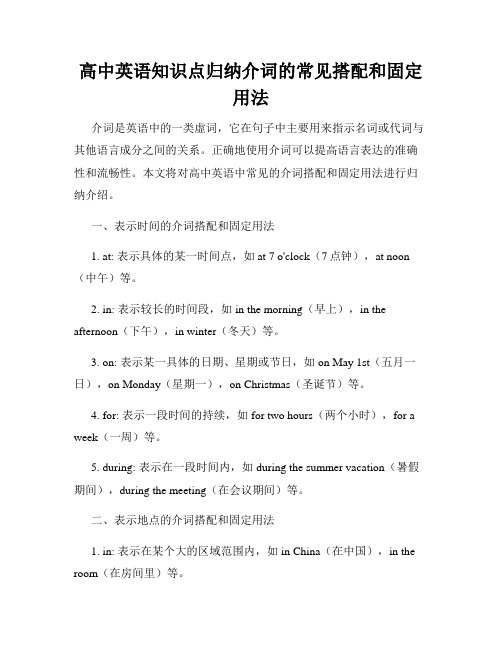
高中英语知识点归纳介词的常见搭配和固定用法介词是英语中的一类虚词,它在句子中主要用来指示名词或代词与其他语言成分之间的关系。
正确地使用介词可以提高语言表达的准确性和流畅性。
本文将对高中英语中常见的介词搭配和固定用法进行归纳介绍。
一、表示时间的介词搭配和固定用法1. at: 表示具体的某一时间点,如at 7 o'clock(7点钟),at noon (中午)等。
2. in: 表示较长的时间段,如in the morning(早上),in the afternoon(下午),in winter(冬天)等。
3. on: 表示某一具体的日期、星期或节日,如on May 1st(五月一日),on Monday(星期一),on Christmas(圣诞节)等。
4. for: 表示一段时间的持续,如for two hours(两个小时),for a week(一周)等。
5. during: 表示在一段时间内,如during the summer vacation(暑假期间),during the meeting(在会议期间)等。
二、表示地点的介词搭配和固定用法1. in: 表示在某个大的区域范围内,如in China(在中国),in the room(在房间里)等。
2. on: 表示在某个较小的平面或曲面上,如on the table(在桌子上),on the ground(在地上)等。
3. at: 表示在某个具体的点上,如at the bus stop(在公交车站),at the cinema(在电影院)等。
4. to: 表示朝向某个地点或方向,如go to school(去学校),look to the future(展望未来)等。
三、表示原因和目的的介词搭配和固定用法1. because of: 表示因为某个原因,如because of the rain(因为下雨),because of his hard work(因为他的努力)等。
英语介词知识点用法总结

英语介词知识点用法总结英语介词知识点用法总结1表示方位的介词:in,to, on 1. in表示在某地范围之内。
如:XXX China.上海在中国的东部。
2. to表示在某地范围之外。
如:Japan is/lies to the east of China.日本位于中国的东面。
3. on表示与某地相邻或接壤。
如:XXX.蒙古国位于中国北边。
2表示计量的介词:at, for, by1. at表示“以……速度”“以……价格”。
如:It flies at about 900 XXX.它以每小时900公里的速度飞行。
I sold my car at a high price.我以高价出售了我的汽车。
2. for透露表现“用……交换,以……为价格”。
如:He sold his car for 500 dollars.他以五百元把车卖了。
注意:at表示单价(price) ,for表示总钱数。
3. by表示“以……计”,后跟度量单位。
如:They paid him by the month.他们按月给他计酬。
Here XXX.在这里鸡蛋是按重量卖的。
3透露表现资料的介词:of, from, in1. of制品仍可看出质料。
如:This box is made of paper.这个盒子是纸做的。
2. from制品已看不出质料。
如:Wine is made from grapes.葡萄酒是葡萄酿成的。
3. in透露表现用某种资料或语言。
如:Please fill in the form in pencil first.请先用铅笔填写这个表格。
XXX.他们用英语交谈。
留意:in指用资料,不消冠词;而with指用工具,要用冠词。
请比力: XXX与draw with a pencil.4表示工具或手段的介词:by, with, on1. by用某种体式格局,多用于交通。
如:XXX乘公共汽车by e-mail.通过电子邮件留意:透露表现搭乘交通工具时,用by时不消冠词,用in时要用冠词。
高中英语知识点归纳介词的用法与搭配

高中英语知识点归纳介词的用法与搭配高中英语知识点归纳:介词的用法与搭配介词在英语中起到连接词或短语之间关系的作用。
熟练掌握介词的用法与搭配对于理解和运用英语语法和表达非常重要。
下面是对高中英语中常用介词的用法与搭配进行归纳总结。
一、介词的基本用法1. of:表示所属关系、来源、构成等。
- The book of John is on the table.(约翰的书在桌子上。
)- The Statue of Liberty was a gift from France.(自由女神像是法国赠送的。
)2. in:表示位置、时间、状态等。
- He is in the room.(他在房间里。
)- I will see you in an hour.(我一个小时后会见你。
)3. to:表示目标、方向等。
- She went to the library to borrow some books.(她去图书馆借书。
) - Please give this letter to him.(请把这封信交给他。
)4. at:表示位置、时间等。
- We will meet at the park.(我们将在公园见面。
)- I have a meeting at 9 o'clock.(我9点有个会议。
)5. for:表示目的、原因等。
- I bought a gift for my friend's birthday.(我为我朋友的生日买了一份礼物。
)- He apologized for being late.(他为迟到而道歉。
)二、介词与名词的常见搭配1. on:- on the table(在桌子上)- on Monday(在星期一)2. in:- in the room(在房间里)- in the morning(在早上)3. at:- at the park(在公园)- at the party(在聚会上)4. to:- go to school(去上学)- talk to the teacher(和老师交谈)5. for:- a gift for her(给她的礼物)- thanks for your help(感谢你的帮助)三、介词与动词的常见搭配1. look at:看- He looked at the picture on the wall.(他看着墙上的画。
介词连词英语知识点总结
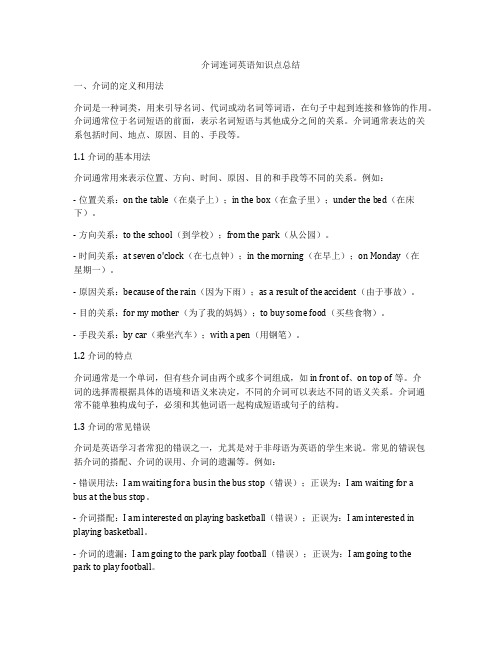
介词连词英语知识点总结一、介词的定义和用法介词是一种词类,用来引导名词、代词或动名词等词语,在句子中起到连接和修饰的作用。
介词通常位于名词短语的前面,表示名词短语与其他成分之间的关系。
介词通常表达的关系包括时间、地点、原因、目的、手段等。
1.1 介词的基本用法介词通常用来表示位置、方向、时间、原因、目的和手段等不同的关系。
例如:- 位置关系:on the table(在桌子上);in the box(在盒子里);under the bed(在床下)。
- 方向关系:to the school(到学校);from the park(从公园)。
- 时间关系:at seven o'clock(在七点钟);in the morning(在早上);on Monday(在星期一)。
- 原因关系:because of the rain(因为下雨);as a result of the accident(由于事故)。
- 目的关系:for my mother(为了我的妈妈);to buy some food(买些食物)。
- 手段关系:by car(乘坐汽车);with a pen(用钢笔)。
1.2 介词的特点介词通常是一个单词,但有些介词由两个或多个词组成,如in front of、on top of等。
介词的选择需根据具体的语境和语义来决定,不同的介词可以表达不同的语义关系。
介词通常不能单独构成句子,必须和其他词语一起构成短语或句子的结构。
1.3 介词的常见错误介词是英语学习者常犯的错误之一,尤其是对于非母语为英语的学生来说。
常见的错误包括介词的搭配、介词的误用、介词的遗漏等。
例如:- 错误用法:I am waiting for a bus in the bus stop(错误);正误为:I am waiting for abus at the bus stop。
- 介词搭配:I am interested on playing basketball(错误);正误为:I am interested in playing basketball。
高中英语介词用法大全

高中英语介词用法大全介词(虚词),不能在句子中独立充当成分。
它总是用于名词、代词、或相当于名词的其它词类或短语活从句前。
需要掌握的介词有11个:in、on、at、to、from、by、with、for、about、after、before。
时间介词的用法辨析1. 时间介词in、on、at、by的用法辨析A.介词in用来表示一天中某段时间,指天、年、月、季节、周次等。
如:in the morningB.介词on用来表示某一天或星期几,指明具体的时间。
如:on a rainy dayC.介词at用来表示特定的时间、节日、年龄等。
如:at noonD.介词by表示…的时候、到、等到…已经等用在天、时间的前面。
如:by 2 o‘clock2. 时间介词in与after的用法辨析A.介词in + 一段时间用于一般将来时。
如:We’ll go to school in two weeks.B.介词after + 一段时间用于一般过去时。
如:My mother came homeafter half an hour.C.介词after + 时间点常用于一般将来时。
如:We’ll go out for awalk after supper.3. 时间介词for与since的用法辨析A.介词for 表示一段时间如:I have been living here for 10 years.B.介词since 表示从过去某一时间以来如:I have been living here since 2000.4. 时间介词during与for的用法辨析A.当所指的时间起止分明时用介词during如:He swims every day during the summer.B.如果一段时间不明确则用介词for如:I haven’t seen her for years.5. 时间介词before与by的用法辨析A.介词before表示“在…之前”如:He won’t come back before five .B.介词by表示“到…时为止,不迟于…”如:The work must be finished by Friday.6. 时间介词till与until用法的异同A.till和until用在肯定句中,均可表示“直到…为止”,如:I will waittill(until)seveno'clock.B.till和until用在否定句中,均可表示“在…以前”或“直到…才”。
- 1、下载文档前请自行甄别文档内容的完整性,平台不提供额外的编辑、内容补充、找答案等附加服务。
- 2、"仅部分预览"的文档,不可在线预览部分如存在完整性等问题,可反馈申请退款(可完整预览的文档不适用该条件!)。
- 3、如文档侵犯您的权益,请联系客服反馈,我们会尽快为您处理(人工客服工作时间:9:00-18:30)。
英语介词知识点用法总结1表示方位的介词:in,to, on1. in 表示在某地范围之内。
如:Shanghai is/lies in the east of China.上海在中国的东部。
2. to 表示在某地范围之外。
如:Japan is/lies to the east of China.日本位于中国的东面。
3. on 表示与某地相邻或接壤。
如:Mongolia is/lies on the north of China.蒙古国位于中国北边。
2表示计量的介词:at, for, by1. at表示“以……速度”“以……价格”。
如:It flies at about 900 kilometers a hour.它以每小时900公里的速度飞行。
I sold my car at a high price.我以高价出售了我的汽车。
2. for表示“用……交换,以……为代价”。
如:He sold his car for 500 dollars.他以五百元把车卖了。
注意:at表示单价(price) ,for表示总钱数。
3. by表示“以……计”,后跟度量单位。
如:They paid him by the month.他们按月给他计酬。
Here eggs are sold by weight.在这里鸡蛋是按重量卖的。
3表示材料的介词:of, from, in1. of成品仍可看出原料。
如:This box is made of paper.这个盒子是纸做的。
2. from成品已看不出原料。
如:Wine is made from grapes.葡萄酒是葡萄酿成的。
3. in表示用某种材料或语言。
如:Please fill in the form in pencil first.请先用铅笔填写这个表格。
They talk in English.他们用英语交谈。
注意:in指用材料,不用冠词;而with指用工具,要用冠词。
请比较: draw in pencil 与draw with a pencil.4表示工具或手段的介词:by, with, on1. by用某种方式,多用于交通。
如:by bus 乘公共汽车by e-mail. 通过电子邮件注意:表示搭乘交通工具时,用by时不用冠词,用in时要用冠词。
请比较:I went there by bus/in a bus.我是坐公共汽车去的那儿。
2. with表示“用某种工具”。
如:He broke the window with a stone.他用石头把玻璃砸坏了。
注意:with表示用某种工具时,必须用冠词或物主代词。
3. on表示“以……方式”,多用于固定词组。
如:They talked on the telephone.他们通过电话进行交谈。
She learns English on the radio/on TV.她通过收音机/电视学英语。
5表示关于的介词:of , about,on1. of仅是提到或谈到过某人或某事。
如:He spoke of the film the other day.他前几天提到了这部影片。
He thought about this matter yesterday.他昨天考虑了这件事。
2. about指“关于”某人或某事物的较详细的情况。
如:Can you tell me something about yourself?你能告诉我一些关于你自己的事情吗?3. on指“关于”学术性的或严肃的事。
如:It’s a textbook on the history of china.它是一本有关中国历史的教科书。
6表原因或理由的介词:for, at,from,of, with, by,because of1. for表示原因,常与sorry, famous, punish, praise, thank, blame等词连用。
如:I am sorry for what I said to you.我后悔不该对你讲那些话。
2. at指情感变化的原因,意为“因听到或看到而……”。
如:He was surprised at the news.听到这消息他大吃一惊。
3. from指“外在的原因”,如受伤、车祸等。
如:He died from the wound.他因受伤而致死。
4. of指“内在的原因”,如病、饿等。
如:The old man died of hunger.老人死于饥饿。
5. with指生理上或情感上的由外界到内心的原因。
如:Hearing the news, he jumped with joy.他们听到这个消息,欣喜若狂。
He was shaking with anger.他气得浑身发抖。
6. by表示外部的,尤其是暴力的或无意中造成某种结果的原因。
如:Her body was bent by age.他因年老背弯了。
She took your umbrella by mistake.我因弄错拿了你的雨伞。
7. because of 表示引起结果的直接原因。
如:He retired last month because of illness/because he ill.他上个月因病退休了!8. owing to多表示引起某不良后果的原因。
如:Owing to the rain they could not come.由于下雨他们没来。
9. thanks to表示引起某种幸运结果的原因,常译为“幸亏……,多亏……”。
如:Thanks to John, we won the game.多亏约翰,我们才赢了这场比赛。
10. out of表示动机的起因,常译为“出于……”。
如:He asked the question out of curiosity.他出于好奇才问了那个问题。
11. through多表示因局部而影响全局的原因。
如:The war was lost through bad organization.战争因组织不周而失败了。
7表示好像或当作的介词:like, as1. like表示“像……一样”,其实不是。
如:Peter the Great, like his country, was strong and proud.彼得大帝像他的国家一样强健和自豪。
2. as表示“作为,以……身份”,其实也是。
如:He talked to me as a father.他以父亲的身份跟我谈话。
注:as作连词时,可表示“好像……”。
如:The work is not so difficult as you imagine.这工作不像你想像的那么困难。
8表示支持或反对的介词:against,foragainst反对,for支持,互为反义词。
如:Are you for my idea or against it?你赞同还是反对我的想法?9表示除某人某物外的介词:besides, except1. besides是包括后面所提人或物在内的“除……外,还”。
如:Thirty students went to the cinema besides him.除他以外,还有30个学生去看了电影。
(他和另外30人都去了)He is interested in tennis besides(=as well as)football.除了足球,他还对网球感兴趣。
2. except是指不包括后面所提人或物在内的“除去”。
如:Everyone is excited except me.除我以外的每个人都很激动。
(他们激动,而我却不激动)All the visitors are Japanese except him.除他以外的所有游客都是日本人。
(其他人是日本人,可他不是)注意:(A) except通常与表示全体的all, every连用;若与other连用,只能用besides。
如:He had other people to take care of besides me.除我之外,他还要照顾别人。
(B) except是排除同类;而except for是排除非同类,常在说明基本情况后,从细节上加上修正。
如:The composition is very good except for a few spelling mistakes.除了几处拼写错误之外,这篇作文整体还是不错的。
(作文与拼写错误是非同类的)但except for也可代替except,特别是在句首时,因为except是不能用于句首的。
如:Except George, you can all go.除乔治外,你们都可以去。
